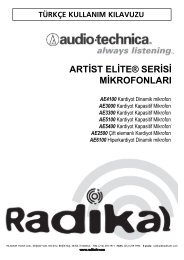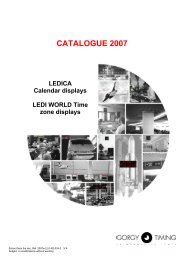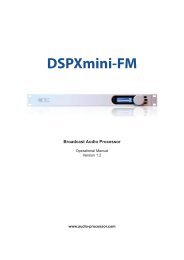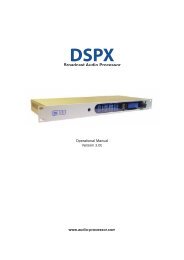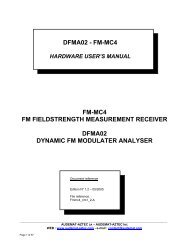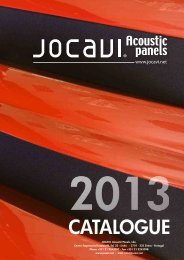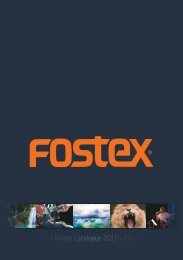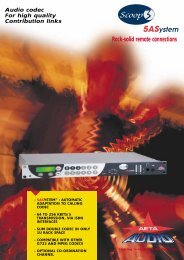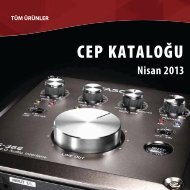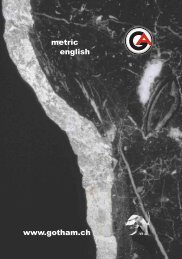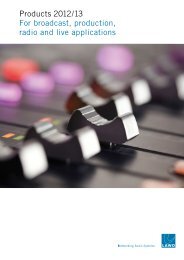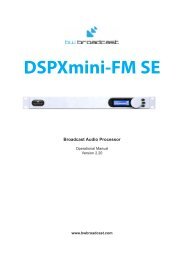general product catalogue - Radikal
general product catalogue - Radikal
general product catalogue - Radikal
Create successful ePaper yourself
Turn your PDF publications into a flip-book with our unique Google optimized e-Paper software.
<strong>product</strong><br />
<strong>catalogue</strong> 2007/2008<br />
The Level Magic block diagram<br />
<strong>product</strong><br />
<strong>catalogue</strong><br />
2007/2008<br />
introduction<br />
Level Magic is consisting of adaptive AGC + Transient Processor + Brickwall limiter. Independent on the leveller<br />
circuits the brickwall limiter is taking care on the peak level all the time.<br />
For the leveller (AGC + Transient Processor) Junger Audio is using a unique combination of QP and RMS level<br />
detectors to analyze the incoming audio signal. In comparing QP and RMS measurement results we can find<br />
out how much transients are coming in. Dependent on that the requested gain change is controlled in relation<br />
between transient processor (fast process) and AGC (slow process).<br />
The characteristic of the gain control by Level Magic level control is mostly determined by the settings of the<br />
Transient Processor. Transient processor is performing fast gain change. In opposite the AGC is doing slow gain<br />
change (depending on settings). The AGC should always be set in a way that the gain change is mostly inaudible<br />
(1dB gain change in 4...5 seconds or slower). The Transient Processor should be set that incoming level<br />
jumps are reduced but originally dynamic range is not changed. As more possible gain change by the Transient<br />
processor as more influence on the dynamic range is coming with.<br />
What makes the Level Magic technology<br />
different from previous dynamic range processors?<br />
A compressor/limiter combination of a known dynamics processor by Junger Audio is always controlling the audio<br />
level in reference to the limiter threshold. In result no headroom is left and the signal is developed to reach a<br />
100% output level. This characteristic is useful to reach maximum levelling for audio disk mastering as well as to<br />
reach 100% modulation for FM transmitters.<br />
In compare to that Level Magic is serving two different levels – operating level and peak level. Between operating<br />
and peak level the “headroom” for possible peaks coming with the audio signal is left. The program level<br />
is controlled in reference to the operating level. Level Magic is a unique algorithm to perform automated audio<br />
level control. It is a combination of an adaptive AGC (automated gain control) with a transient processor followed<br />
by a brickwall limiter. The combination of an AGC circuit with a transient processor using a sophisticated level<br />
analyzing circuit is the key to get a satisfying output level control for any kind of input level changes.<br />
Which <strong>product</strong>s are using Level Magic technology?<br />
www.junger-audio.com<br />
LEVEL<br />
MAGIC <br />
Level Magic Lite 2ch leveller, analogue/digital I/O, setup & operation by web interface<br />
d06web 2ch leveller, sophisticated circuit design, power-fail bypass, analogue/digital I/O,<br />
setup & operation by web interface<br />
d06front+web same as d06 web, additional front panel operation<br />
d07 2ch transmission processor, signal processing for FM transmission incl.<br />
Level Magic, analogue/digital I/O, web interface, sophisticated<br />
circuit design, power-fail bypass<br />
b46 4ch leveller, digital I/O, optional SDI interface (HD/SD) for processing<br />
embedded audio, sophisticated circuit design, power-fail bypass<br />
C8046 4ch leveller, DSP card for the modular C8000 system<br />
C8086 8ch leveller, Level Magic Surround (5.1), DSP card for the C8000 system<br />
C80x46/C80x86 4ch/8ch leveller in combination with HD/SD-SDI interface for C8000<br />
page 3



